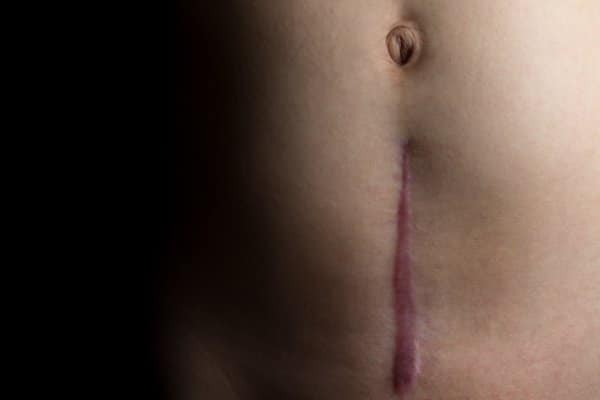Caesarean section births are on the rise throughout the world. Global rates increased 12.4% from 1990 to 2014 according to a review published in 2016.¹ Because of the risk of infection, rapid and complete healing of the caesarean section wound is a high priority for doctors and new mothers. A recent study from researchers in Tehran found better healing outcomes for incisions treated with platelet rich plasma.
Caesarean Section Deliveries
Vaginal birth is still preferred over C-section delivery. Natural birth benefits the infant’s immune system by populating the child with microbes from the journey through the birth canal, while a history of c-section complicates future pregnancies. But if complications arise during labor, caesarean deliveries save lives. C-section is most commonly recommended for mothers carrying multiples or breech positioning. The procedure requires an incision across the lower abdomen which makes it a major abdominal surgery that requires subcutaneous stitches and staples to close the wound.
Platelet Rich Plasma Increases C-Section Incision Healing

A 2016 controlled trial included 138 mothers randomized into two groups. For the treatment group, researchers prepared PRP in the operating room from 55 cc of whole blood, drawn into a syringe containing citrate as an anticoagulant. The mixture underwent centrifugation at 3200 rpm for 15 minutes to separate 4-5 ml of PRP. Physicians applied PRP subcutaneously with a syringe after the fascia was closed, but before the final sutures. Wounds in the control group were treated with a standard saline rinse and closed according to protocol.²
A doctor who was blind to the group allocation process evaluated each incision on day 1, day 5 and 2 months after delivery. Researchers chose to evaluate scars at 8 weeks specifically, because it takes 8 weeks for the scar to form maximum tensile strength. Scars were assessed according to the REEDA scale which evaluates several factors; redness, edema, ecchymosis, discharge, and approximation of the wound edges. Lower REEDA scores indicate superior healing. Other assessed outcomes included pain according to VAS (the Visual Analogue Scale) and scar keloid formation according to VSS (the Vancouver Scar Scale).²
Researchers found better REEDA, VAS and VSS scores at every evaluation period in the treatment group. PRP increased local healing responses which decreased pain, keloid, and hypertrophic scar formation. The PRP group showed a 43% reduction in REEDA scores after day 5, while control group scores decreased 25%. Statistical analysis was conducted according to Mauchly’s sphericity test. Overall differences in REEDA scores reached statistical significance and VSS scores were statistically significant after day five. Wounds treated with PRP were less painful for the patient healed faster than the control group.²
How Does PRP Improve Wound Healing?

In a healthy individual, platelets flow through the blood at a concentration of 150,000 to 450,000 platelets per microliter of whole blood.³ Platelet rich plasma increases the body’s innate healing responses by delivering a concentration of platelets directly to injured tissues. Because PRP is prepared from the patient’s own blood (autologous), there is no risk of allergic reaction. Current preparation methods concentrate platelets anywhere from 3-7 times baseline blood levels. Once injected into damaged tissues platelets begin to degranulate, releasing beneficial growth factors such as epidermal growth factor which stimulates endothelial chemotaxis and angiogenesis, connective tissue growth factor known to promote fibrosis and platelet adhesion, and transforming growth factor which regulates collagen synthesis and collagenase secretion.³
Based on the methods description, it appears that the researchers in the aforementioned study utilized leukocyte rich PRP (L-PRP), though the authors don’t specifically describe the PRP composition. PRP containing leukocytes has microbial properties and has been shown to increase local immune response which is helpful for preventing infection at the incision site. L-PRP could be counterproductive in treating osteoarthritis or tendinopathies where inflammation is a part of the a problem, in such cases or pure PRP delivers growth factors without exacerbating inflammation.⁴
The level I evidence presented in this randomized controlled trial is beneficial to the field of regenerative medicine and general surgery by showing how the addition of a simple PRP procedure can benefit wound recovery. Future studies could be improved by discussing PRP composition and including platelet counts at baseline and in the final preparation.
- Betrán AP, Ye J, Moller A-B, Zhang J, Gülmezoglu AM, Torloni MR. The Increasing Trend in Caesarean Section Rates: Global, Regional and National Estimates: 1990-2014. Zeeb H, ed. PLoS ONE. 2016;11(2):e0148343. doi:10.1371/journal.pone.0148343.[ncbi]
- Tehranian A, Esfehani-Mehr B, Pirjani R, Rezaei N, Sadat Heidary S, et al. Application of Autologous Platelet-Rich Plasma (PRP) on Wound Healing After Caesarean Section in High-Risk Patients, Iran Red Crescent Med J. 2016 ;18(7):e34449. doi: 10.5812/ircmj.34449.[ircmj]
- Williams, Marlene MD. What are Platelets and Why are They Important?. Heart and Vascular Institute, Johns Hopkins Medicine. Accessed 3.13.2018.[hopkinsmedicine]
- Dhurat R, Sukesh M. Principles and Methods of Preparation of Platelet-Rich Plasma: A Review and Author’s Perspective. Journal of Cutaneous and Aesthetic Surgery. 2014;7(4):189-197. doi:10.4103/0974-2077.150734.[ncbi]

Get an Instant Quote:
*We Typically Call Within 15 Minutes!





